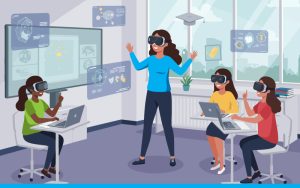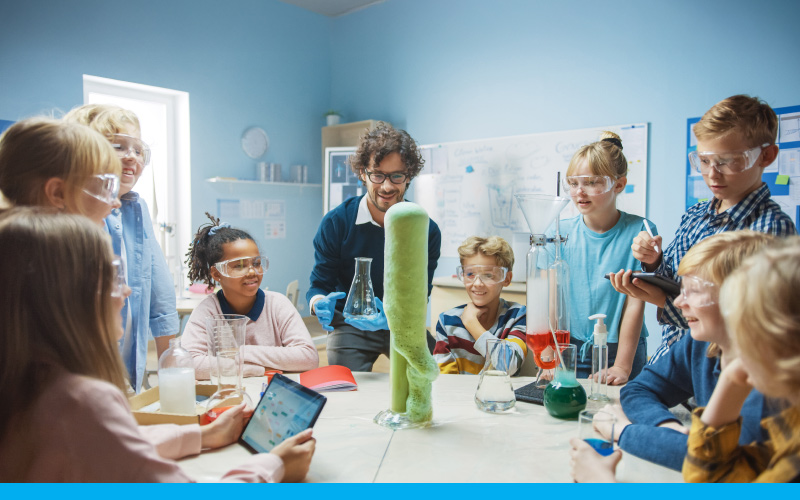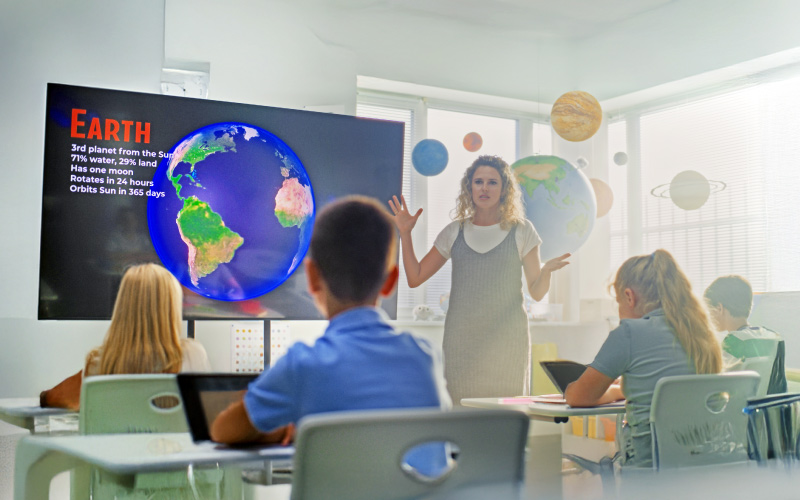In recent years, Augmented Reality (AR) has emerged as a game-changing tool in education, particularly in STEM (Science, Technology, Engineering, and Mathematics) learning. AR technology is defined as a technology where the real world and virtual images are combined and simultaneous interaction between real and virtual objects is provided. Therefore, augmented reality complements reality rather than completely replacing it.
By blending the physical and digital worlds, AR in education creates immersive, interactive experiences that make complex concepts more accessible and engaging for K12 students.
This blog explores how AR in education is revolutionizing STEM learning, the benefits it brings to the classroom, and why it’s a critical tool for preparing students for a technology-driven future.
What is AR in Education?
Augmented Reality (AR) overlays digital content—such as images, videos or 3D models—onto the real world through devices like smartphones, tablets, or AR glasses. Unlike Virtual Reality (VR), which creates a fully immersive digital environment, AR enhances the real world by adding interactive elements.
In the context of STEM learning, AR in education allows students to visualize abstract concepts, conduct virtual experiments, and explore interactive models, making learning more dynamic and hands-on.
How AR in Education is Transforming STEM Learning
1. Visualizing Complex Concepts
One of the biggest challenges in STEM education is helping students understand abstract or complex ideas. AR in education bridges this gap by bringing these concepts to life. For example:
- Biology: Examining the human body and organs in detail and seeing the organs in their real size and shapes constitute more permanent and effective learning.
- Chemistry: AR can simulate molecular structures, allowing students to manipulate and observe chemical reactions in real-time.
- Astronomy: Students can use AR to explore the solar system, visualizing planetary orbits and celestial phenomena.
By making these concepts tangible, AR in education fosters deeper understanding and retention.
2. Interactive and Engaging Learning Experiences
AR in education transforms passive learning into an active, engaging process. Instead of reading about scientific principles or engineering designs, students can interact with them directly. For instance:
- Physics: AR apps can simulate gravity, friction, or motion, allowing students to experiment with different variables and observe outcomes.
- Engineering: Students can design and test virtual prototypes, identifying flaws and improving their designs in real-time.
This hands-on approach not only makes learning fun but also encourages curiosity and critical thinking.
3. Virtual Labs and Experiments
Not all schools have access to fully equipped labs, but AR in education can level the playing field. Virtual labs powered by AR enable students to conduct experiments safely and cost-effectively. For example:
- Chemistry: Students can mix virtual chemicals to observe reactions without the risk of accidents.
- Environmental Science: AR can simulate ecosystems, allowing students to study the impact of environmental changes.
These virtual experiences ensure that all students, regardless of resources, can participate in high-quality STEM learning.
4. Collaborative Learning Opportunities
AR in education also promotes collaboration among students. Many AR applications allow multiple users to interact with the same digital content simultaneously, encouraging teamwork and communication. For example, students can work together to solve a virtual engineering challenge or explore a shared AR model of a historical artifact.
This collaborative approach mirrors real-world STEM careers, where teamwork and problem-solving are essential.
Benefits of AR in Education for STEM Learning
1. Enhanced Engagement and Motivation
AR in education captures students’ attention by making learning interactive and fun. Students can manipulate 3D models of molecular structures, simulate engineering projects, or explore virtual ecosystems—all within a dynamic, hands-on environment. This increased engagement leads to higher motivation and a greater interest in STEM subjects. Studies show that AR-driven lessons increase student participation as the technology aligns with Gen Z’s affinity for digital interactivity. Teachers observe heightened enthusiasm, with students voluntarily extending lab time to continue exploring AR simulations, demonstrating how immersive tools turn passive learning into an engaging intellectual adventure.
2. Improved Understanding and Retention
AR bridges the gap between theoretical knowledge and practical application by visualizing complex ideas in real time. Abstract concepts like electromagnetic fields, cellular processes, or geometric theorems become tangible through interactive overlays. In K-12 classrooms, AR apps like GeoGebra AR help students grasp calculus and geometry by plotting equations in physical space, turning intimidating formulas into intuitive spatial relationships.
3. Accessibility and Inclusivity
AR in education ensures that all students, regardless of their school’s resources, can access high-quality STEM learning experiences. Schools lacking advanced lab facilities can use AR apps like Labster to conduct virtual chemistry experiments or physics simulations, ensuring equitable learning opportunities. It also supports diverse learning styles – Visual learners benefit from 3D models and animations, auditory learners engage with narrated AR content, kinesthetic learners manipulate virtual objects through gesture-based controls.
Tools like Microsoft’s Seeing AI assist visually impaired students by converting diagrams into audio descriptions, while AR platforms like Merge EDU offer tactile experiences for neurodiverse learners.
4. Preparation for the Future
AR equips students with technical fluency and problem-solving skills critical for modern STEM careers. Industries such as healthcare, aerospace, and architecture increasingly rely on AR for tasks like surgical training, mechanical prototyping, and virtual site inspections. Educational programs integrating tools like Microsoft HoloLens or
Unity Mars allow students to collaborate on AR engineering projects, mirroring real-world workflows.
AR equips students with technical fluency and problem-solving skills critical for modern STEM careers. Industries such as healthcare, aerospace, and architecture increasingly rely on AR for tasks like surgical training, mechanical prototyping, and virtual site inspections. Educational programs integrating tools like Microsoft HoloLens or Unity Mars allow students to collaborate on AR engineering projects, mirroring real-world workflows.
The Future of AR in Education
As AR technology continues to evolve, its potential in STEM learning is limitless. Future advancements may include more immersive AR experiences, integration with AI for personalized learning, and expanded accessibility for schools worldwide.
By embracing AR in education, we can create a generation of students who are not only proficient in STEM subjects but also equipped with the creativity, critical thinking, and problem-solving skills needed to thrive in the 21st century.
Conclusion
AR in education is more than just a technological trend—it’s a powerful tool that’s transforming how students learn and engage with STEM subjects. By making learning interactive, accessible, and fun, AR is helping to bridge the gap between theoretical knowledge and real-world applications.
As educators and policymakers continue to invest in AR in education, we can ensure that every student has the opportunity to explore, experiment, and excel in STEM. The future of education is here, and it’s augmented.
- Debdut Pramanickhttps://www.mitrmedia.com/resources/blogs/author/debdutp/
- Debdut Pramanickhttps://www.mitrmedia.com/resources/blogs/author/debdutp/
- Debdut Pramanickhttps://www.mitrmedia.com/resources/blogs/author/debdutp/
- Debdut Pramanickhttps://www.mitrmedia.com/resources/blogs/author/debdutp/









